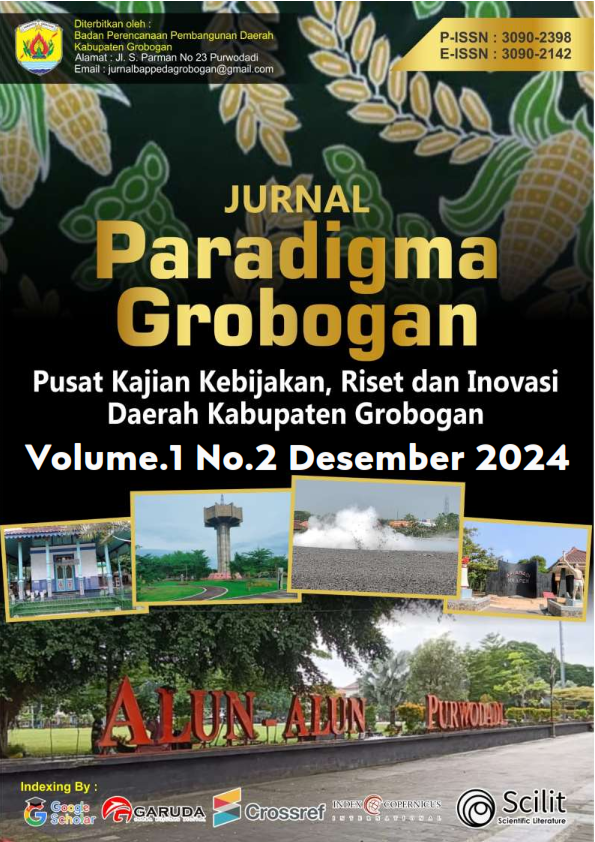Pengaruh Kepemimpinan Kepala Sekolah dan Budaya Organisasi terhadap Implementasi Kebijakan Sekolah Ramah Anak di Sekolah Menengah Pertama (SMP) Kota Semarang
DOI:
https://doi.org/10.58684/paradigma.v2i1.54Keywords:
Child-Friendly School, Regression, Principal Leadership, Organizational Culture, Organizational CommitmentAbstract
Many junior high schools (SMP) in Semarang City have implemented Child-Friendly School (CFS)–based education. The implementation of policies in schools, including CFS, is influenced by several factors such as leadership, organizational culture, and organizational commitment. This study aims to examine the influence of principal leadership and organizational culture on the implementation of CFS in junior high schools in Semarang City, both directly and indirectly through organizational commitment as an intervening variable. This research employed a quantitative approach with a hypothesis-testing study design, involving 135 respondents comprising teachers and education personnel from six junior high schools in Semarang City. Data were collected using questionnaires, and data analysis was conducted through linear regression and path analysis with IBM SPSS Statistics 23. The results showed that principal leadership did not have an effect on organizational commitment, while organizational culture had a significant effect on organizational commitment in junior high schools in Semarang City. Furthermore, both principal leadership and organizational culture were proven to influence the implementation of CFS, and organizational commitment also affected the implementation of CFS. However, organizational commitment was not able to mediate the relationship between principal leadership and organizational culture with the implementation of CFS.
References
Abdulaziz, A., Bashir, M., & Alfalih, A. A. (2022). The impact of work-life balance and work overload on teacher’s organizational commitment: do Job Engagement and Perceived Organizational Support matter? Education and Information Technologies, 27(7), 9641–9663. https://doi.org/10.1007/s10639-022-11013-8
Acar, A. Z. (2012). Organizational Culture, Leadership Styles and Organizational Commitment in Turkish Logistics Industry. Procedia - Social and Behavioral Sciences, 58, 217–226. https://doi.org/10.1016/j.sbspro.2012.09.995
Ajzen, I. (1991). The Theory of Planned Behavior. Organizational Behavior and Human Decision Processes, 50(2), 179–211.
Ananda, S., & Winata, H. (2017). Upaya meningkatkan komitmen organisasi melalui perilaku kepemimpinan. Jurnal Pendidikan Manajemen Perkantoran, 2(1), 78–86.
Baharun, H., Wibowo, A., & Hasanah, S. N. (2021). Kepemimpinan Perempuan Dalam Menciptakan Sekolah Ramah Anak. Quality, 9(1), 87. https://doi.org/10.21043/quality.v9i1.10109
Bass, B. M., & Avolio, B. J. (1994). Improving Organizational Effectiveness through Transformational Leadership. Thousand Oaks: SAGE Publications.
Biermann, F., Kanie, N., & Kim, R. E. (2017). Global governance by goal-setting: The novel approach of the UN Sustainable Development Goals. Current Opinion in Environmental Sustainability, 26–27, 26–31. https://doi.org/10.1016/j.cosust.2017.01.010
Brissett, N. O. M. (2023). The Education Sustainable Development Goal 4: A Critical Appraisal. International Encyclopedia of Education (4th Ed), 539–546. https://doi.org/10.1016/B978-0-12-818630-5.01025-3
Deal, T. E., & Peterson, K. D. (2009). Shaping School Culture. San Francisco: Jossey-Bass.
Dunn, W. N. (1998). Pengantar Analisa Kebijakan Publik. Yogyakarta: Gadjah Mada University Press.
Dwyer, S., Richard, O. C., & Chadwick, K. (2003). Gender diversity in management and firm performance: The influence of growth orientation and organizational culture. Journal of Business Research, 56(12), 1009–1019. https://doi.org/10.1016/S0148-2963(01)00329-0
Hulpia, H., Devos, G., Rosseel, Y., & Vlerick, P. (2012). Dimensions of Distributed Leadership and the Impact on Teachers’ Organizational Commitment: A Study in Secondary Education. Journal of Applied Social Psychology, 42(7), 1745–1784. https://doi.org/10.1111/j.1559-1816.2012.00917.x
Johansson, S., Myrberg, E., & Toropova, A. (2022). School bullying: Prevalence and variation in and between school systems in TIMSS 2015. Studies in Educational Evaluation, 74, 101178. https://doi.org/10.1016/j.stueduc.2022.101178
Leithwood, K., & Jantzi, D. (2005). Transformational leadership. In B. Davies (Ed.), The Essentials of School Leadership (pp. 31–43). London: SAGE Publications.
Leithwood, K., Mascall, B., Strauss, T., Sacks, R., Memon, N., & Yashkina, A. (2007). Distributing Leadership to Make Schools Smarter: Taking the Ego Out of the System. Leadership and Policy in Schools, 6(1), 37–67. https://doi.org/10.1080/15700760601091267
Meyer, J. P., & Allen, N. J. (1991). A Three-Component Conceptualization of Organizational Commitment. Human Resource Management Review, 1(1), 61–89.
Munandar. (2001). Budaya Organisasi. Jakarta: Gramedia.
Robbins, S. P., & Judge, T. A. (2009). Perilaku Organisasi. Jakarta: Salemba Empat.
Schein, E. H. (2010). Organizational Culture and Leadership (4th ed.). San Francisco: Jossey-Bass.
Somech, A., & Bogler, R. (2002). Antecedents and Consequences of Teacher Organizational and Professional Commitment. Educational Administration Quarterly, 38(4), 555–577.
Subarsono. (2013). Analisis Kebijakan Publik: Konsep, Teori, dan Aplikasi. Yogyakarta: Pustaka Pelajar.
Sugiyono. (2016). Metode Penelitian Kuantitatif, Kualitatif dan R&D. Bandung: Alfabeta.
UNICEF. (2009). Child-Friendly Schools Manual. New York: UNICEF.
Vito, R. (2020). Key variations in organizational culture and leadership influence: A comparison between three children’s mental health and child welfare agencies. Children and Youth Services Review, 108, 104600. https://doi.org/10.1016/j.childyouth.2019.104600
Yao, H., & Ma, L. (2024). Improving teacher career satisfaction through distributed leadership in China: The parallel mediation of teacher empowerment and organizational commitment. International Journal of Educational Development, 104, 102960. https://doi.org/10.1016/j.ijedudev.2023.102960





